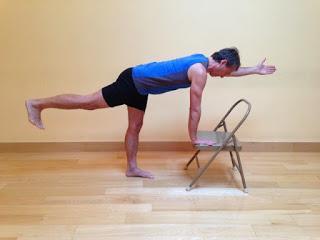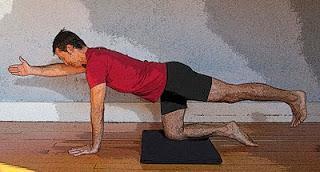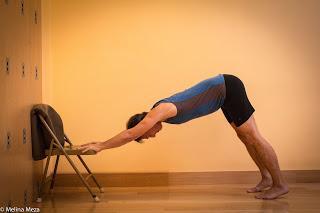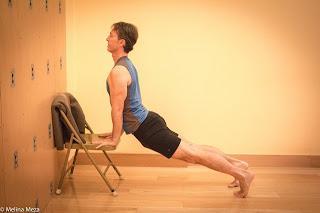Q: I wonder if you have advice on mixed level classes of the sort where some might enjoy even a pared back flow up and down from the floor, and others have issues (particularly with knees and hips) which mean they need to be using a chair for poses like Dog, Plank or Uttanasana.
I have tried one solution, which is to demonstrate the chair poses for visual identification, while talking those flowing on the mat through their moves. This can work but is tricky if you also have people working on the mat who are not familiar with the poses! But we know it is important to keep people moving up and down from the floor, so we wouldn’t want to ask those who can to work solely with a chair. Any advice here would be enormously appreciated.
A: Almost all of my classes these days are mixed level classes, including from rank beginners up to intermediate level students. And as the years have gone on, there is a growing minority of the students who have a variety of issues—from back issues and knee and hip issues to balance challenges and loss of strength and agility—that make transitioning from standing to sitting on the floor to standing difficult.
Let me say up front that the way you are already working with your students is actually quite interesting and may be worth trying for our readers who are also confronted by the same teaching challenge. But my favorite way of addressing new students who don’t know the poses yet, able bodied students of all levels, and my students with challenges in getting up and down from the floor, is to take everyone through a through an individual pose or vinyasa in advancing stages of difficulty, from easiest (such as the chair variations) to the versions on the floor on hands and knees (for example, Hunting Dog pose) or hands and feet (such as Downward-Facing Dog pose). This, of course, assumes you have enough props, chairs, wall space, etc., for everyone to try the easier versions at the same time.
To illustrate, let’s start with an example of an individual pose, Hunting Dog. There is a nice version that is done from a standing position, using a chair seat for the hands, which will have benefits for everyone in class regardless of ability (which I emphasize in my comments to the class, pointing out how this higher version might strengthen one area or stretch another effectively, for instance).
 I start by taking everyone through this version on each side once or twice. I then specifically invite those who cannot get up and down easily to repeat the chair version, as I move on to demonstrating the floor version for the newer students who might not be familiar with it. Then I have those who can do the floor version try it, while the others are still practicing the chair version.
I start by taking everyone through this version on each side once or twice. I then specifically invite those who cannot get up and down easily to repeat the chair version, as I move on to demonstrating the floor version for the newer students who might not be familiar with it. Then I have those who can do the floor version try it, while the others are still practicing the chair version. For vinyasas, I extend this by teaching the entire vinyasa using elevated modifications with a chair or a wall. Then, after asking my group with limitations to repeat the vinyasa with elevated modifications, I demonstrate the classic vinyasa for those who can do it. For example, for Sun Salutations, my first demo would be of doing a chair version of Sun Salutations (or several of the poses in that sequence, such as Downward-Facing Dog and Upward-Facing Dog), and my second demo would be the classic version of the vinyasa for those who can do it.
For vinyasas, I extend this by teaching the entire vinyasa using elevated modifications with a chair or a wall. Then, after asking my group with limitations to repeat the vinyasa with elevated modifications, I demonstrate the classic vinyasa for those who can do it. For example, for Sun Salutations, my first demo would be of doing a chair version of Sun Salutations (or several of the poses in that sequence, such as Downward-Facing Dog and Upward-Facing Dog), and my second demo would be the classic version of the vinyasa for those who can do it. 
 My experience has been that everyone is actually open to and quite fine with this method of learning, and I often hear back from my more able students that they had never been exposed to the chair or wall versions and found them both interesting, engaging, and useful. For example, one student mentioned how she would try some of those poses at work, where she did not wish to get down on the floor anyway but still wanted to be able to do some small practice on her work breaks. And my students with limitations seem satisfied repeating their chair or propped options to have a safe and effective way to practice yoga that meets them where they are.
My experience has been that everyone is actually open to and quite fine with this method of learning, and I often hear back from my more able students that they had never been exposed to the chair or wall versions and found them both interesting, engaging, and useful. For example, one student mentioned how she would try some of those poses at work, where she did not wish to get down on the floor anyway but still wanted to be able to do some small practice on her work breaks. And my students with limitations seem satisfied repeating their chair or propped options to have a safe and effective way to practice yoga that meets them where they are. However, if you want some different ideas, Nina is also providing her thoughts on the subject below.
And I am sure many of our readers have also experience in this area, so if you do please write in and tell us your favorite way of welcoming students of all abilities to your classes.
—Baxter
A: Personally, I would ask for help! For a class like this, if I could find someone who is training to be a teacher and wants experience teaching people who need to use chairs, I would bring that person in to help co-demonstrate with me. I would probably also divide the class up physically so that those who need chairs were on one side and the others who don’t need them were on the other side. And then I’d have one person demonstrating the chair version of the flow in front of the chair-using folks while the other person is demonstrating the classic version in front of those who can practice it. That way, everyone has someone to follow when they’re practicing and no one has to do a chair version of a flow if they don’t want to.
If it is not possible to find an assistant, I would ask one or more of my more experienced students to help with the demonstrations. In the tradition I come from, teachers often ask their students to demonstrate for the class, which gives you the ability to point things out while they’re doing the pose (it’s also a good way to protect your body from overuse injuries). You could either have one student help by demonstrating the flow they have have experience while you do the other one or even have two students doing a side-by-side demonstrations as you talk the class through the flow.
—Nina
Subscribe to Yoga for Healthy Aging by Email ° Follow Yoga for Healthy Aging on Facebook ° Join this site with Google Friend Connect

